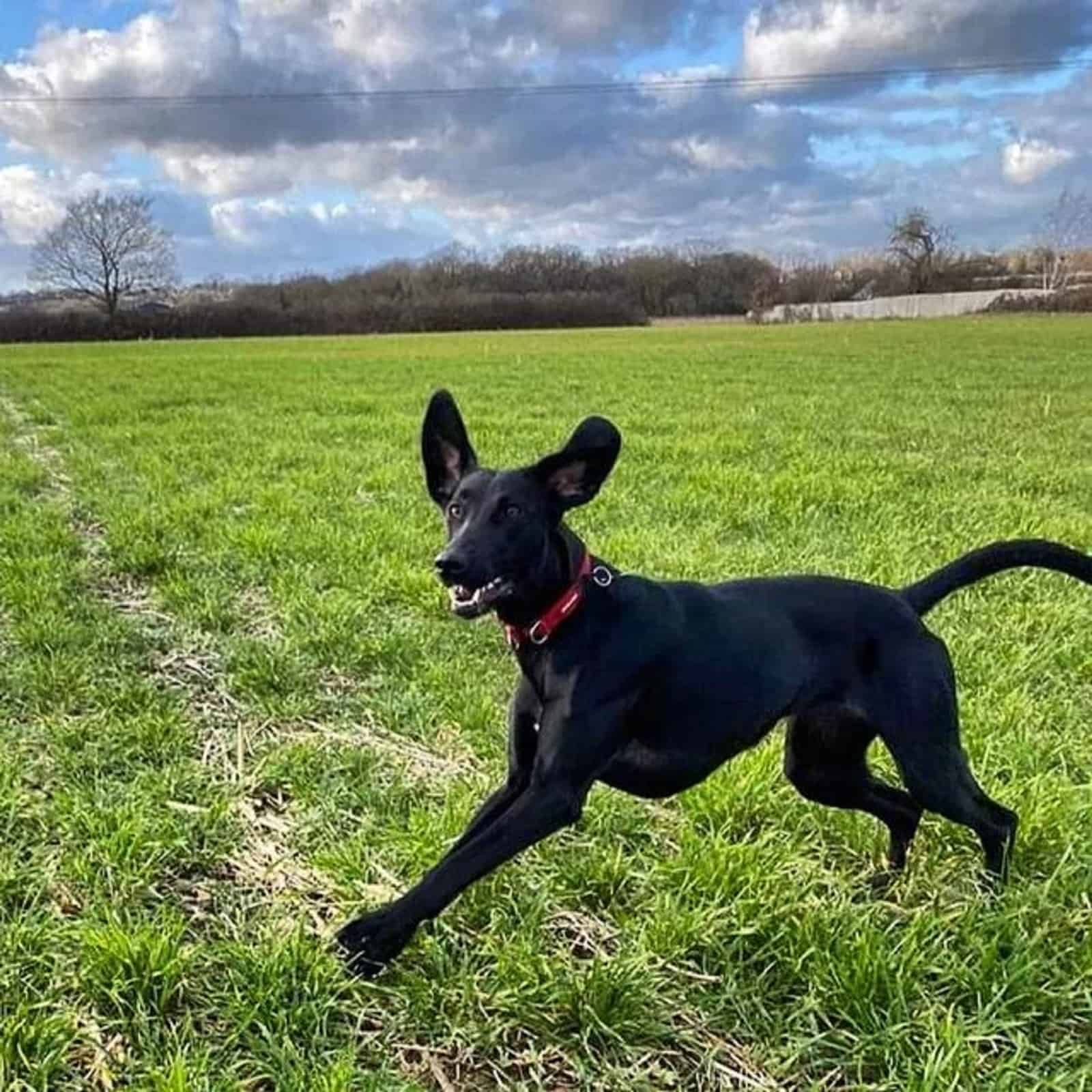Activity buffs, this one is for you. What was once considered unaccomplishable is now a reality, and the combination of Labrador retriever and Whippet is an option for everyone who likes high-intensity playtime.
The Lab Whippet mix is perhaps not the most popular mixed breed, but those who know what they are looking for are more than aware of its existence. Some of you might know how it looks and behaves, while others are curious about it without concrete information.
To please both groups, I wrote this article with the intent of explaining everything about these silly speedsters known as Whipadors. Among dog breeds, these two parent breeds are experts at what they do, so a blend of both should pack a punch.
Whipador Defining Features

Thinking about the Labrador retriever’s unfaltering will to please blended with the Whippet’s Greyhound-like speediness can make your heart race. The athletic body inherited from the Whippet parent will make it aero and hydrodynamic.
The floppy ears on a slim body make for a mild-mannered face that is affectionate with the family, great with small children, but a nightmare for small animals. A strong prey drive means stress for guinea pigs, hamsters, cats, or anything that will trigger their chasing instinct.
A pointed muzzle with a triangular head means they will perfectly fit under your or your guests’ arms while craving cuddles. It will occasionally bark, but not like a purebred Labrador retriever. Moderate to high trainability means obedience training will be successful with minimal effort.
However, a Lab Whippet mix is a high-energy dog, so you will have to organize exercise and playtime for its needs. That means a lot of running, swimming, hiking, or agility courses for good sleep and no boredom.
Being left alone for prolonged periods of time will certainly cause separation anxiety because the Labrador parent gave it the best friend gene. Though they are generally friendly dogs, early socialization is necessary for successful dog park visits.
Whippet Labrador mixes can be a lot to handle for dogs that do not know them, and the crazy amounts of energy can come across as aggressive or unwelcome in a dog park where everyone knows each other.
While this is a snippet of what the Whipador has to offer, there is plenty more to talk about in terms of physical appearance and temperament. We should start with a detailed physical feature list.
A Hybrid Dog Built For Speed And Stamina

In most cases, dogs are either extremely fast for short periods of time or moderately fast for long periods of time. The Whipador’s body is not perfect for relentless high-speed chases.
Standing at twenty to twenty-four inches tall and weighing in at thirty-five to seventy-five pounds, this crossbreed can run for hours without breaking a sweat but breaking the sound barrier. This means, you will be getting a medium-sized dog.
A slimmer body frame than the Lab’s but bulkier than the Whippet dog’s gives a great balance of explosive strength and endurance. The triangle-shaped skull with a mildly pronounced stop that narrows towards the nose creates little air resistance.
Long legs, with some of the Labrador bone thickness, give the Whipador good pulling power without skimping on effortlessly moving at great speeds. The lower back is slightly slanted and ends with a medium-length pointy tail.
The chest is well-developed, with a neat tuck at the loins, accentuating the fit silhouette. Shoulders and hips are muscular without impacting the ease of movement. Legs are placed perpendicularly to the elbows and hind quarters without any arching.
Coat, Color, And Grooming
While a short coat is guaranteed, the possibilities of a Whipador include a smooth or double coat. Many features are predictable, but coat quality and color are the true luck of the draw features.
Despite the “limited” coat quality options, you will enjoy a wide variety of coat color combinations. The Whippet parent contributes almost two dozen colors, while the Labrador has distinct black, chocolate, and yellow coloring.
It seems as though the Lab Whippet mix prefers inheriting the color from the Labrador parent, but some interesting middle-ground swatches are possible. Markings are possible, too, with the black and white colors most frequently combined.
The most frequent pattern found on a Lab Whippet mix is brindle, but the occasional sable Whipador can sprout from the litter.
The Whipador is a low to moderate shedder with little grooming needs, but since the coat quality and color are frequently inherited from the Lab side, you might want to brush or furminate your mix once or twice a week.
Running Eighty In A Thirty Zone

You will not get any speeding tickets for your Lab Whippet mix sprinting down the road, but their physical attributes mirror the temperament (or vice versa). We already know that anything mixed with a Lab will have incredible drive and love for the family, so how is the Whipador different?
Some alone time can be beneficial for your Whippet Lab if you have an active household. However, the Lab within will always find ways to convert that into playtime. Great family pets bring joy to the guests too. Nobody will be afraid of these do-gooders.
Where there is a lot of energy, there is a lot of physical exercise, and to keep their brain from going into full destruction mode, you will need to plan out a structured training regime. You are in luck because they are highly trainable and respond best to positive reinforcement.
A Whippet Lab puppy will need early socialization if you are bringing it into a home where small animals already reside. A strong prey drive might be too stressful for your birds, cats, guinea pigs, etc.
Being active dogs, playtime alone will not suffice for energy expenditure. They are quite apt at jumping over fences, so consider your fence height. Small dogs will probably be ok with a Whipador, but only if their relationship is monitored from the start.
Houses with a large yard will definitely better suit the Lab Whippet mix, but an apartment with intense outdoor daily exercise should not impact its quality of life. Watchdog instincts are average at best, so if you are looking for an alert dog, other breeds or crossbreeds might be a better fit.
Health Problems, Diet, And Life Expectancy

There are a few health issues the Lab Whippet mix is prone to, and they are mostly congenital. This means that choosing a reputable breeder will make a whole world of difference in its lifespan.
Regular core vaccines are a must, which does not mean non-core shots are optional. For the best possible condition of your Whipador, schedule an appointment with a vet who understands the specificity of each parent breed and the mix itself.
Because a purebred Whippet requires a strict diet and feeding regime, you will have to adequately manage calorie intake. A healthy dog needs the right balance of nutrients, hence the need for a thought-out diet plan.
Hypothyroidism
One of the most important glands in the body, the thyroid, regulates many metabolic functions such as body temperature, normal organ function, digestion, and nutrient absorption.
While the thyroid is not a self-controlled gland, but second to the pituitary gland in the chain of command, hypothyroidism is usually caused by lymphatic thyroiditis or, less frequently, by idiopathic thyroid gland atrophy.
Even rarer is thyroid cancer, where fat cells form in the gland instead of its own. Lymphatic thyroiditis is an autoimmune condition of congenital origin. It causes the immune system to detect the thyroid as a foreign object that needs to be neutralized.
The destruction of thyroid tissue causes an underproduction of thyroxine and triiodothyronine, which are crucial for normal metabolism. This results in a slowed metabolic rate and several symptoms that are in direct correlation with metabolism.
Those symptoms include weight gain without increased food consumption, lethargy, sensitivity to low temperatures, slow heart rate, exercise intolerance, poor coat condition, hair loss, etc.
Although there is no cure for hypothyroidism, treatment with synthetic hormone replacement therapy has a high success rate with a good prognosis. Since your doggy will have to take this therapy for the rest of its life, some dietary and lifestyle adjustments are recommended.
Skin Cancer
This is one of the conditions that can be harder to treat, depending on which of the three types of cancer a dog has. Mast cell carcinoma is the by far the most common skin cancer in dogs, but malignant melanoma and squamous cell carcinoma are present, too.
Mast cell tumors do not have a clear point of origin, but studies suggest a strong correlation between irritant exposure and genetics with skin cancer.
A mast cell is produced in the bone marrow and is the driving force behind prompt immune reactions to inflammation, allergens, parasites, and bacteria.
A mast cell tumor (MCT) usually presents itself as a pustule on the skin, so confusing it with an insect bite or an allergic reaction is common. In many cases, the diagnosis via Fine Needle Aspiration is established only once the cancer progresses.
Treating it can include surgery, chemotherapy, and radiation. Surgical removal is dependent on the size of the tumor, while chemotherapy is used for shrinking larger masses to operable dimensions. Radiation is useful for remains that are inoperable.
Certain dog breeds that are more prone to MCT include the Labrador retriever, Beagle, and Boston terrier. The Whippet, and in turn, the Lab Whippet mix, are prone to squamous cell carcinoma, which is believed to be caused by sun exposure and the papillomavirus.
Breeds with thin coats and light-colored skin are most at risk from SCC, and the Whippet is joined by Pitbulls and Greyhounds as a dog breed with a predisposition for squamous cell carcinoma.
Hip And Elbow Dysplasia
This is one of the more common congenital conditions that signify poor breeding practices. Genetic anomalies are hereditary, so your Whipador can inherit these genetic conditions from one or both parents.
Simply put, dysplasia means that the ball part of the joint does not have a perfect fit with the socket. It develops in dogs at a young age when bone and cartilage tissue are still forming and maturing.
The looseness of the hip or elbow joint means that the cartilage providing cushion and smoothness between the two bones wears off, causing the ball and socket to grind against each other.
Moving around extends the damage beyond repair, and normal walking, lying, or sitting can become painful for your dog. Early stages can be successfully treated with NSAIDs to provide pain relief and reduce inflammation, but more advanced dysplasia will require surgery.
In most cases, a femoral head ostectomy is the best option for dogs that have a higher percentage of motor ability in the joint but do not react to NSAID therapy. Hip replacement surgery is performed on dogs that have a severe movement impediment due to dysplasia.
Diet And Food Habits
A special doggy requires a special diet. Sighthound dogs are the ultimate coursing dog, so their nutritional needs will reflect the sport they specialize in. Bursts of speed are reliant on a fit body with low body fat and solid muscle mass.
For this reason, a Whipador must be on a low to moderate-carb, low-fat, high-protein diet. However, completely excluding carbs is not necessary. In addition, vitamins and minerals are crucial, so supplements will be necessary if your dog is highly active.
The percentages should be around twenty-two percent protein, twenty-percent carbohydrates, and under five percent fat. Complex carbs such as whole grains must be avoided because dogs do not have the enzymes to break them down. Fat content should be fatty acids, not any fat.
Fish oil is a great supplement to add to your Lab Whippet mix’s meals as a source of omega-3 fatty acids. Nuts and seeds are great for adding some omega-6 and omega-9 into the diet.
You can choose from a few diet options like dry dog foods, homecooked, or a raw diet. If you are a first-time dog owner, a raw food diet might not be the best choice, so high-quality dry food like kibble will be your best bet.
Life Expectancy
The parent breeds have a good lifespan despite a predisposition to some genetic diseases, so the Whippet Lab mix should live anywhere between twelve and fifteen years.
As this is a hybrid dog, we can only talk about “guesstimates”, but a minimum of twelve years is great news. If you feed it a healthy diet and regularly bring it for a vet checkup, you should have yourself a speed demon and best friend for a while.
A Whippet And A Labrador Retriever Walk Into A Bar…
They hit it off great, and you get a Whipador. Scratch the poor jokes aside, and we are left with a few more blanks to fill in. That is why getting to know the parents makes a world of difference when talking about a hybrid dog.
The Labrador retriever and the Whippet are physically and temperamentally different but have a few similarities overall. Since either parent breed can entirely take over one of these sets of features, their looks and brains are equally important things to consider.
Knowing your dog’s lineage always gives great insight into what it needs, so a quick trip to 1850s Canada and nineteenth-century England is in order.
If Dogs Pulled Santa’s Sleigh, They Would Be Labs

Dashing through the snow with some lumber on the sleigh, the Labrador retriever is a descendant of the St. John’s Dog. It is believed English fishermen used them to retrieve fish while helping around with pulling and hunting tasks too.
With time, the long-haired ancestor was bred to better fit the people’s needs, so a short-haired version with a double coat became the norm for the Newfoundland native breed. The short coat made the frozen water melt faster, and that meant more work was done in less time.
As an ode to the Labrador retriever’s childish charm, the fishermen used them to entertain people with all kinds of tomfoolery, like dancing and playing fetch. Later on, the entertainment business appeared to suit the Lab more than “manual” labor, so the fishermen started selling them.
Catching the eye of English royalty with their impressive display of cooperation and retrieving work, they decided to use them for hunting, too, with an effort to preserve the original bloodlines brought over from Canada.
The modern Labrador is the funniest worker you could possibly imagine, without ever changing to the point of forgetting where it came from, which is why it has been the number one most popular dog breed in the US, according to the American Kennel Club.
Riding A Whippet Would Give You Whiplash
Historical definitions of fun might not be synchronous with the ones we have now, but watching a smaller version of the Greyhound take on a pigeon in a straight-line race would get me hyped for sure.
Whippet “rag racing” was a favorite pastime of blue-collar workers of nineteenth-century England. Though coursing game was the original job for the Greyhound, it was “downsized” to a Whippet with the purpose of helping miners put a stop to rodent infestations.
Nobody knows about the when or how of the Whippet’s inception, but many strongly believe that English terrier breeds were used at some point to instill a strong prey drive in a dog that is otherwise ninety-five percent sighthound.
Just like many other dog breeds, the Whippet slowly became a dog that owners and handlers loved to show. Its unique silhouette and body proportions, paired with a laid-back temperament outside of work, raised the companionship stocks through the roof.
Nowadays, Whippets are dedicated to comfortable living, and they are great at doing nothing. It is exactly for that reason that I had to write an article on its ancestor’s weight management.
Whippet And Lab Physical Appearance

Slightly longer than its nineteen to twenty-two inches height and weight of twenty-five to forty pounds, the Whippet dog’s anatomy is tailored to high-speed sprinting. This makes for a slim, athletic body frame.
On the other hand, the Lab’s square frame at twenty-two and a half inches in height and weight of sixty-five to eighty pounds is more muscular and built for strength.
The Whippet’s skull is elongated with no features that break the slender narrowing of the muzzle towards the nose. Ears are hanging when resting but semi-erect when the dog is alert.
The Lab’s skull is squarish with a stop that is defined but not overpronounced. The muzzle is medium-length with no narrowing towards the nose. Hanging, triangular ears remain floppy even when alert.
Whippets have a deep-seated chest, while Labradors have a medium-width chest that seamlessly transitions to more muscular shoulders. Hindquarters in a whippet are slim but muscular, as opposed to the Lab’s more substantial hips.
A big difference lies in the back. A Whippet’s back has a pronounced slope at the lower section (characteristic of the breed), and a Lab straight back conforms to the square body shape.
Similarly, the tail is thin and long with a natural hang in the Whippet dog, but the “otter-shaped” thick tail that ends in a point is a trademark of the Labrador retriever.
Coat Quality, Color, And Grooming
Both dogs feature a short coat, with the Lab having an undercoat. There are over twenty colors and patterns that the Whippet is known for, but only three in the Lab that is strikingly different in both looks and rarity — yellow Lab, black Lab, and chocolate Lab.
There are more color possibilities for a Lab, which you can read about in our comprehensive Lab color article. Keep in mind that only the three mentioned above are recognized as breed standard by the AKC.
Labrador retrievers are heavy shedders, but grooming that short coat is extremely easy. One or two brushing sessions a week should keep things under control. Whippets are much easier on people with allergies due to the lack of an undercoat, and grooming is a breeze.
Labrador And Whippet Temperament
When you say family dog, the first breed that comes to mind is probably the Labrador retriever. They are arguably the best dog for those who like liveliness in their home. Whippets are more laid-back and prefer coziness when not “working”.
Both breeds were used as hunting dogs, which means a strong prey drive will require early socialization with other small animals. If it is smaller than either of these dogs, it will be a target for chasing.
You will find that Whippets are less playful than the playtime masters (Lab, of course). Whether you live in an apartment or a house, you will have to provide plenty of exercise for either breed, with the Whippet requiring more focused physical activity.
Training either dog will be relatively easy, but do keep in mind Whippets are dogs that value their time alone. Positive reinforcement is a must with both dogs since they are very sensitive by nature.
Labrador retrievers seem to have unending pools of energy, whereas Whippets know their limits. Whippets rarely bark, but the Labrador retriever is no stranger to small talk. Protective instincts are the same with both, but a Lab will be more alert in certain situations.
Socialization
Labs and Whippets alike do great with other dogs and are astonishingly patient with young children. Their will to please and be with their family is very pronounced, so do not leave them alone for prolonged periods of time, or you might find destruction at home.
Labrador retrievers are naturally more curious, so they will require a little bit more mental stimulation. Whippets are fine with structured training, but they are not that keen on brain gymnastics in their free time.
Labradors connect with owners and family on a far deeper level than Whippets, which is why they are the breed of choice for therapy, support, and service dogs.
Of course, Whippets love their family, but their slightly more individualistic personality does not make them as good at working in the previously mentioned occupations.
You will have to slowly introduce either breed to new things, as they can get overexcited. Meeting strangers is no problem, but teaching them how to greet new or even familiar people can help you avoid a lot of unwanted situations.
Common Health Problems Of Whippets And Labs

A few health issues that plague these two breeds are mostly congenital, and choosing a breeder that is open about parent health screening and a medical record proving healthy bloodlines.
Though genetics play a major role in Whippet and Labrador health, a common problem is weight gain. An overweight dog will be more likely to develop secondary conditions that can reduce its lifespan. Let us quickly go through some of these conditions.
Obesity
Labrador retrievers are known to eat a lot, and owners often play into their hands. Overfeeding is a major problem in modern society, and dogs are often induced into our lifestyles which are sometimes not adequate for a dog.
Being overweight is bad, but obesity is much more than that. Dogs that are obese are more prone to developing hip dysplasia, diabetes mellitus, hypothyroidism, and other conditions that affect the bones and metabolism.
Following a diet that is rich in protein but low in fat and carbs will yield the best results for a majority of dogs. Counting the treats in the daily calories will prevent you from teaching your dog these unhealthy eating habits.
Whippets that are kept as companion dogs are more likely to become overweight and obese due to their inclination towards a couch potato life when not running. They require a strict diet and regular, high-intensity physical exercise to burn off calories.
Mitral Valve Disease (MVD)
Sighthounds are plagued by heart problems due to their genetics. Breeding for a certain purpose may be beneficial for tasks in the human world but less favorable for a healthy dog.
This condition can be congenital but also arise due to an infection or from “wearing out”. It is described as a leakage of blood from the left ventricle back into the atrium, causing a heart murmur and lowering the heart’s efficiency.
Although a heart murmur is the main symptom, other, more noticeable signs can include progressive exercise intolerance, labored breathing, high blood pressure, etc.
Treatment includes several drugs, but since MVD usually leads to congestive heart failure, the use of inotropic and ACE inhibitors is the therapy of choice. The condition affects many dog breeds, including the Lab, but not nearly as frequently as Whippets.
Bloat And GDV
Both Whippets and Labs are fast eaters, so eating a lot of food in one sitting and then running around is a recipe for disaster. Though bloat is not usually serious in humans, it can be fatal for dogs.
If air or gas from the stomach becomes trapped between large chunks of food, it can cause the buildup of gases that have nowhere to go. The pressure inside the stomach will rise and will cause gastric dilatation.
Untreated bloat that distends the stomach can progress into volvulus, which is when the stomach twists and turns. This is incredibly painful for the dog and requires emergency intervention.
The diaphragm and surrounding organs come under great pressure from the distension, reducing, or sometimes completely cutting off, blood flow into the vital organs. Volvulus is treated by surgery.
Preventing bloat by giving your dog two or three smaller meals per day is much easier than risking surgery or even death. Both Whippets and Labrador retrievers are more prone to bloat due to their deep-seated chests.
Summary
Whippet Lab mix puppies ought to be cute, but make sure you check the reputation of the breeders. There are many so-called breeders that breed dogs to profit off of people who do not research enough.
Simply saying that a dog is a Lab Whippet mix does not mean it is true. Always ask for parent-breed pedigrees, along with health records that prove no genetic disease is present in the bloodline.
Another option is checking out rescue centers for hybrid dogs that look like the Whipador. Since physical and temperamental traits can be quite unpredictable in many cases, getting a rescue might be the best way to get a knack for mixed breeds.
Finally, I hope you are now more knowledgeable about Whipadors and also had fun reading the article.
